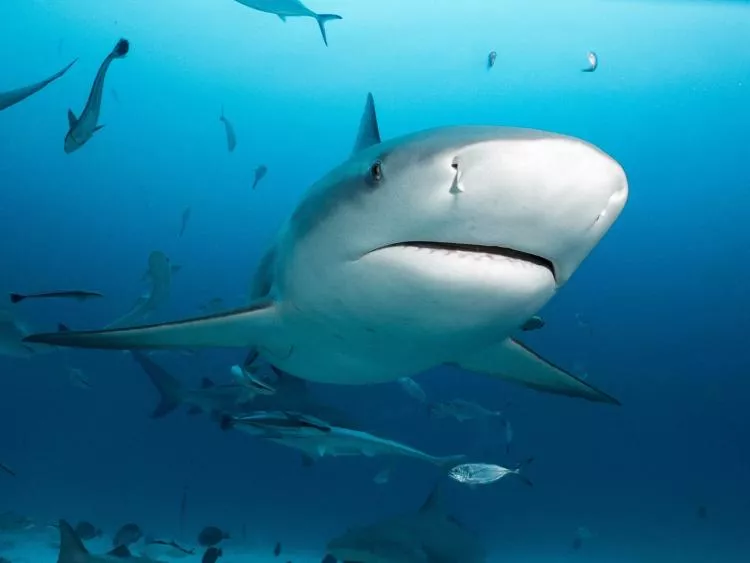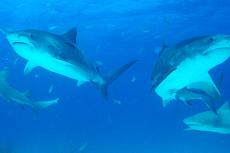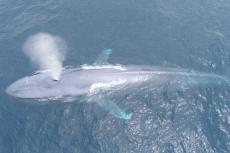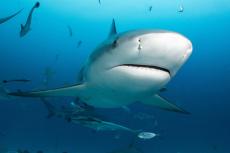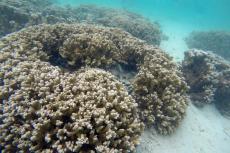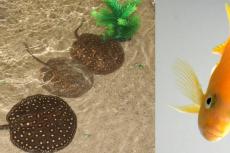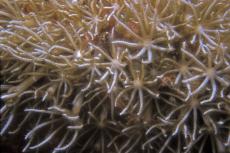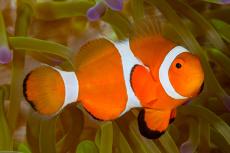Reevaluating shark societies: Challenging the myth of dominance-subordination hierarchies
A recent study evaluates the evidence for dominance-subordination hierarchies in sharks. These are widely believed to dictate shark behaviour, though no remotely convincing demonstration of such hierarchies in any species of Chondrichthyan has been presented.
In 1954, Warder C. Allee and Joshua C. Dickinson conducted an experiment on the smooth dogfish aimed at establishing dominance-subordination hierarchies in Chondrichthyans. This pioneering study, which lacked subsequent testing and analysis, has laid the groundwork for a persistent belief in rigid social structures among sharks. The dominance-subordination hierarchy, which is modelled on the social structure of the chicken, was proposed without convincing evidence in the context of Chondrichthyan vertebrates. It has affected the study of shark behaviour ever since, and stood in the way of the search for the true understanding of their societies.

The experiment and its flaws
Allee and Dickinson’s experiment involved placing sixteen smooth dogfish in confined tanks and observing their behaviour. In such a situation, no shark who wanted to escape the proximity of another could do so, and no shark who wanted to establish a region for him or herself, could be rid of the others.
In a species with a dominance-subordination hierarchy, this would facilitate high levels of aggression, yet, in spite of active efforts by the researchers to provoke competition for food among the sharks, including starving them for up to six days, they were unable to do so.
Not one clear incidence of aggression involving dominance-subordination was seen, though the stated purpose of the experiment was to establish just such behaviour. This absence of agonistic incidents challenged the establishment of dominance-subordination hierarchies, but with no explanation, the researchers used collision avoidance to claim that dominance and subordination was present.
Though they did not identify the mechanism by which the presumed dominance was enforced, they concluded that their experiment had established that dominance-subordination hierarchies are present in Chondrichthyes.
Thus, the foundational study by Allee and Dickinson, which is still cited as having established dominance-subordination hierarchies in sharks, lacks robust scientific support.
Subsequent studies: Challenging the status quo
Subsequent studies of elasmobranch behaviour, including blacktip reef sharks, bull sharks and lemon sharks, consistently contradicted the notion of dominance-subordination hierarchies. Observations revealed a lack of intra-specific aggression, with sharks displaying social behaviours contrary to the expected territoriality and conflict. Instead, the term “heterarchy,” emphasizing flexible responses based on individual variation, cognition, and circumstances, emerged as a more appropriate descriptor for shark social communities.
Sharks develop relationships with conspecifics through interactions that begin in the nursery, and respond to each other as individuals. Individual and social differences have been found to explain the apparently complex organization of what is interpreted as social networks. The perceived absence of rigid hierarchies challenges the long-held belief that sharks operate within dominance-subordination structures.
The observed collision avoidance among confined sharks is attributed to the sharks’ natural instinct for self-protection rather than complex societal analyses. Given their lack of the protection of a bony skeleton and their much smaller mass, self-preservation is a more plausible explanation for the tendency of smaller sharks to avoid collisions.
Rethinking shark societies
As we continue to unravel the mysteries of marine life, it is essential to approach shark behaviour with an open mind and a willingness to explore alternative explanations, fostering a deeper understanding of the intricacies of elasmobranch societies beyond oversimplified narratives. Sharks, it appears, have unique and complex social relations that differ significantly from traditional models based on terrestrial species. The challenge now is to unravel the intricacies of shark societies and redefine our understanding of their social dynamics.
About the author
Ethologist Ila France Porcher, author of The Shark Sessions and The True Nature of Sharks, conducted a seven-year study of a four-species reef shark community in Tahiti and has studied sharks in Florida with shark-encounter pioneer Jim Abernethy. Her observations, which are the first of their kind, have yielded valuable details about sharks’ reproductive cycles, social biology, population structure, daily behaviour patterns, roaming tendencies and cognitive abilities. Please visit: ilafranceporcher.wixsite.com/author.
REFERENCES
Allee DG, Dickenson JC (1954) Dominance and subordination in the smooth dogfish, Mustelus canis(Mitchell). Physiol. Zool., 27: 356–364.
Andreev PS, Zhao W, Wang NZ, Smith MM, Li Q, Cui X, Zhu M, Sansom IJ (2020) Early Silurian chondrichthyans from the Tarim Basin (Xinjiang, China). PLoS ONE 15(2): e0228589. https://doi. org/10.1371/journal.pone.0228589
Brena PF, Mourier J, Planes S, Clua E (2015) Shark and ray provisioning: Functional insights into behavioral, ecological and physiological responses across multiple scales. Mar Ecol Prog Ser 538:273-283
Brena PF, Mourier J, Planes S, Clua E (2018) Concede or clash? Solitary sharks competing for food assess rivals to decide. Proc. R. Soc. B 285: 20180006. http://dx.doi.org/10.1098/rspb.2018.0006
Castro JI (2017) The origins and rise of shark biology in the 20th century. Mar. Fish. Rev. 78: 1433.
Chase ID (1982) Dynamics of hierarchy formation: The sequential development of dominance relationships. Behaviour, 80(3-4), 218-239. doi: https://doi.org/10.1163/156853982X00364
Coates MI, Finarelli JA, Sansom IJ, Andreev PS, Criswell KE, Tietjen K, Rivers ML, La Riviere PJ (2018) An early chondrichthyan and the evolutionary assembly of a shark body plan. Proc. R. Soc. B 285: 20172418. http://dx.doi.org/10.1098/rspb.2017.2418
Compagno LJV (1984) FAO Species Catalogue, Vol. 4. Sharks of the world: An annotated and illustrated catalogue of shark species known to date, Part 2 - Carcharhiniformes. FAO Fish. Synop.125(4/2):251-655. Rome: FA
Drews, C (1993) The concept and definition of dominance in animal behaviour. Behaviour 125.3/4: 283–313.
Fallows C, Gallagher AJ, Hammerschlag N. (2013). White sharks (Carcharodon carcharias) scavenging on whales and its potential role in further shaping the ecology of an apex predator. PLoS ONE 8(4): e60797. https://doi.org/10.1371/journal.pone.0060797
Firth JA, Sheldon BC, Brent LJN (2017) Indirectly connected: Simple social differences can explain the causes and apparent consequences of complex social network positions. Proc. R. Soc. B 284, 20171939. (doi:10.1098/rspb.2017.1939)
Frisch AJ, Ireland M, Rizzari JR, Lönnstedt OM, Magnenat KA, Mirbach CE, Hobbs JPA (2016) Reassessing the trophic role of reef sharks as apex predators on coral reefs. Coral Reefs 35, 459–472. doi.org/10.1007/s00338-016-1415-2
Gauthreaux Jr, SA (1978) The ecological significance of behavioral dominance. Social Behavior (pp. 17-54). Springer US.
Guttridge T, Gruber S, Franks B, Kessel S, Gledhill K, Uphill J, Krause J, Sims D (2012) Deep danger: intra-specific predation risk influences habitat use and aggregation formation of juvenile lemon sharks Negaprion brevirostris. Mar. Ecol. Prog. Ser. 445, 279 – 291. (doi:10.3354/meps09423)
Heupel MR, Lédée EJI, Simpfendorfer CA (2018) Telemetry reveals spatial separation of co-occurring reef sharks. Mar. Ecol. Prog. Ser. 589:179–192
Klimley AP, Nelson DR (1981) Schooling of the scalloped hammerhead shark, Sphyrna lewini, in the Gulf of California. Fish Bull 79: 356–360. doi: 10.1111/j.1095-8649.2009.02230.x
Klimley AP (1987) The determinants of sexual segregation in the scalloped hammerhead shark, Sphyrna lewini. Environ Biol Fish 18, 27–40. https://doi.org/10.1007/BF00002325
Klimley AP (2023) A historical approach to describing the complex behaviour of a large species of carnivorous shark. Case study No. 1: The scalloped hammerhead, Sphyrna lewini. Behaviour(published online ahead of print 2023). doi: https://doi.org/10.1163/1568539X-bja10211
Klimley AP, Clua EE, Porcher IF, Pratt HL (2023) A review of the behaviours of the Chondrichthyes: A multi-species ethogram for the chimaeras, sharks, and rays. Behaviour.
Lage CA, Wolmarans W, Mograbi DC (2022) An evolutionary view of self-awareness. Behav. Processes. 194:104543. doi: 10.1016/j.beproc.2021.104543. Epub 2021 Nov 17. PMID: 34800608.
Lorenz K (1963) Das Sogenannte Böse, Zur Naturgeschichte der Aggression. Verlag Dr Borotha-Schoeler, Vienna, Austria.
Maljkovic A, Côté IM (2011) Effects of tourism-related provisioning on the trophic signatures and movement patterns of an apex predator, the Caribbean reef shark. Biological Conservation (2) 859-165 Elsevier.
Martin RA (2007) A review of shark agonistic displays: comparison of display features and implications for shark–human interactions. Marine and Freshwater Behaviour and Physiology 40.1:3-34.
Mourier J, Vercelloni J, Planes S (2012) Evidence of social communities in a spatially structured network of a free-ranging shark species. Anim. Beh. doi:10.1016/j.anbehav.2011.11.008
Mourier J, Planes S (2015) Les requins et raies des îles Australes, espèces emblématiques de la conservation. p. 113-119
Salvat B, Bambridge T, Tanret D, Petit J (2015) Environnement marin des îles Australes, Polynésie française. Institut Récifs Coralliens Pacifique, CRIOBE, The Pew Charitable Trusts Polynésie française. Polynésie française, Tahiti, p. 342.
Mourier J, Lédée E, Guttridge T, Jacoby DMP (2019) Network analysis and theory in shark ecology–methods and applications. In Shark Research: Emerging Technologies and Applications for the Field and Laboratory, eds. JC Carrier, MR Heithaus, CA Simpfendorfer (Boca Raton: CRC Press), 337–356.
Mucientes GR, Queiroz N, Sousa LL, Tarroso P, Sims DW (2009) Sexual segregation of pelagic sharks and the potential threat from fisheries. Biol. Lett.5156–159
Murdy EO, Birdsong RS, Musick JA (1997) Fishes of Chesapeake Bay. Smithsonian Institution Press Washington and London. 324 p.
Myrberg Jr. AA, Gruber SH (1974) The behavior of the bonnethead shark, Sphyrna tiburo. Copeia1974(2):358-374.
Papastamatiou YP, Caselle JE, Friedlander AM, Lowe CG (2009) Distribution, size frequency, and sex ratios of blacktip reef sharks (Carcharhinus melanopterus) at Palmyra Atoll: a predator-dominated ecosystem. Journal of Fish Biology, 75: 647-654. https://doi.org/10.1111/j.1095-8649.2009.02329.x
Papastamatiou YP, Bodey TW, Friedlander AM, Lowe CG, Bradley D, Weng K, Priestley V, Caselle JE (2018) Spatial separation without territoriality in shark communities. Oikos, 127: 767-779. https://doi.org/10.1111/oik.04289
Piiper J, Meyer M, Worth H, Willmer H (1977) Respiration and circulation during swimming activity in the dogfish Scyliorhinus stellaris. Respiration Physiology, 30: 1–2 221-239 ISSN 0034-5687 doi.org/10.1016/0034-5687(77)90032-9.
Pini-Fitzsimmons J, Knott NA, Brown C (2021) Heterarchy reveals social organization of a smooth stingray (Bathytoshia brevicaudata) population in a provisioned food context front. Mar. Sci., Sec. Marine Megafauna, Volume 8 https://doi.org/10.3389/fmars.2021.641761
Porcher IF (2010) The shark sessions: My sunset rendezvous. Strategic Book Publishing, Traverse City, Michigan, USA. (Updated 2020)
Porcher IF (2020) Outwitted by chickens: The bird who killed the tiger. Independent Impression. USA
Porcher IF (2022) Commentary on emotion in sharks. Behaviour, 159(8-9), 849-866. doi: https://doi.org/10.1163/1568539X-bja10145
Porcher IF (2022) C. melanopterus behaviour at Session 304. www.youtube.com/watch?v=_Wi7Q0rlYk8
Porcher IF (2023) Ethogram for blacktip reef sharks (Carcharhinus melanopterus). Behaviour.
Rago PJ, Sosebee KA, Brodziak JK, Murawski SA, Anderson ED (1998) Implications of recent increases in catches on the dynamics of northwest Atlantic spiny dogfish (Squalus acanthias). doi.org/10.1016/S0165-7836(98)00181-7
Ritter EK (2001) Food-related dominance between two carcharhinid shark species, the Caribbean reef shark, Carcharhinus perezi, and the blacktip shark, Carcharhinus limbatus. Marine and Freshwater Behaviour and Physiology [Mar. Freshwat. Behav. Physiol.]. Vol. 34, no. 2, pp. 125-129.
Robbins RL (2007) Environmental variables affecting the sexual segregation of great white sharks Carcharodon carcharias at the Neptune Islands South Australia. Journal of Fish Biology, 70: 1350-1364. https://doi.org/10.1111/j.1095-8649.2007.01414.x
Sabando MA, Rieucau G, Bradley D, et al. (2020) Habitat-specific inter and intraspecific behavioral interactions among reef sharks. Oecologia 193, 371–376 (2020). https://doi.org/10.1007/s00442-020-04676-y
Schjelderup-Ebbe T, Katz D (1921) Beiträge zur Sozialpsychologie des Haushuhns. Zeitschrift für Psychologie 88, 225 – 252.
Sperone E, Micarelli P, Andreotti S, Spinetti S, Andreani A, et al. (2010) Social interactions among bait-attracted white sharks at Dyer Island (South Africa). Mar Biol Res 6: 408–414. doi: 10.1080/17451000903078648
Sperone E, Micarelli P, Andreotti S, Brandmayr P, Bernabò I, Brunelli E, Tripepi S (2012) Surface behaviour of bait-attracted white sharks at Dyer Island (South Africa), Mar. Biol. Res. 8(10): 982-991. Doi: 10.1080/17451000.2012.708043
Springer, S (1967) Social organization of shark populations. In Sharks, Skates, and Rays, eds. Gilbert PW, Mathewson RF, Rail DP. Baltimore, MD: Johns Hopkins Pr. pp. 149-74.
Thibaut B, Nicolas L, Adam B, Marosi ND, Brunnschweiler JM (2021) Companions and casual acquaintances: The nature of associations among bull sharks at a shark feeding site in Fiji. Front. Mar. Sci 8: Doi: 10.3389/fmars.2021.678074
Zemah-Shamir Z, Mourier J, Ilany A, et al. (2022) Preliminary insights of a mixed-species shark aggregation: A case study of two carcharhinids from the Mediterranean Sea. Environ Biol Fish 105, 623–634 (2022). https://doi.org/10.1007/s10641-022-01280-2


